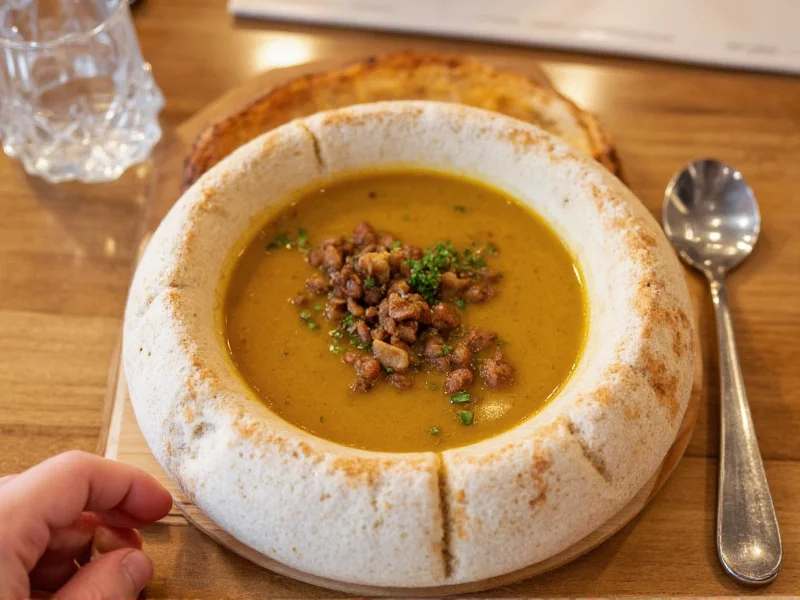When pairing soup with a bread bowl, texture and temperature play crucial roles in creating the perfect dining experience. Bread bowl soups represent a beloved culinary tradition that combines hearty soup with edible servingware, but not all soups work equally well in this format. Understanding which soups complement bread bowls can transform an ordinary meal into something extraordinary.
Why Certain Soups Work Better in Bread Bowls
The ideal bread bowl soup maintains a delicate balance between liquid content and thickness. Soups that are too thin will seep through the bread too quickly, causing structural failure before you finish eating. Conversely, soups that are overly thick might not properly coat the bread interior, missing the opportunity for flavor infusion.
Sourdough bread bowls remain the most popular choice due to their sturdy structure and tangy flavor profile that complements many soup varieties. The bread's crust provides necessary rigidity while the interior absorbs just enough soup to enhance flavor without collapsing.
| Best Soup Types | Why They Work | Recommended Bread Type |
|---|---|---|
| Clam Chowder | Cream-based with chunky ingredients that maintain thickness | Sourdough boule |
| Broccoli Cheddar | Cheese creates protective layer inside bread | Artisan wheat |
| Potato Soup | Starchy base resists sogginess | Rye bread |
| Tomato Bisque | Smooth texture with natural acidity | French bread bowl |
| Cream of Mushroom | Earthy flavors complement bread's sweetness | Sourdough |
Cream-Based Soups: The Ideal Bread Bowl Partners
Cream-based soups consistently perform best in bread bowls due to their viscosity and fat content. The dairy or cream components create a natural barrier that slows moisture absorption into the bread. When preparing cream of mushroom soup for bread bowl service, consider adding a touch more roux to increase thickness without compromising flavor.
Professional chefs recommend warming bread bowls slightly before filling to create a protective layer. This simple technique, often overlooked in home cooking, significantly extends the structural integrity of your bread bowl. The gentle heat causes the bread's interior starches to set, creating a more effective moisture barrier.
Soups to Avoid with Bread Bowls
Clear broths and consommés make poor choices for bread bowl service. These thin liquids penetrate the bread structure too rapidly, causing premature collapse. Even when using heartier bread varieties, traditional French onion soup typically fails as a bread bowl candidate because the melted cheese topping interferes with the bread's ability to absorb soup properly.
Acidic soups like gazpacho present another challenge. The high acidity accelerates the breakdown of bread structure, resulting in a mushy texture within minutes. If serving acidic soups in bread bowls, consider lining the interior with a thin layer of melted butter first to create a temporary moisture barrier.
Perfecting Your Bread Bowl Technique
Mastering the art of bread bowl soup service requires attention to several key factors. First, select bread with a thick crust and tight crumb structure. Artisan breads typically outperform mass-produced varieties due to their superior texture and flavor profile. When hollowing out the bread, leave at least a 1/2 inch wall thickness throughout to maintain structural integrity.
Temperature management proves critical for optimal bread bowl performance. Serve soup at 165-175°F (74-80°C)—hot enough to keep the bread slightly crisp but not so hot that it accelerates sogginess. Many restaurants brush the interior with melted butter or olive oil before adding soup, creating an additional moisture barrier that extends serving time by several minutes.
Gluten-Free Bread Bowl Alternatives
For those following gluten-free diets, traditional bread bowls present challenges. Several innovative alternatives have emerged in recent years. Cauliflower-based bowls offer structural integrity while maintaining a neutral flavor profile. Some chefs create gluten-free bread bowls using a blend of rice flour, tapioca starch, and xanthan gum that mimics traditional bread texture.
When using gluten-free bread for soup service, consider pre-baking the hollowed bread at 350°F (177°C) for 5-7 minutes to create a more resilient structure. This additional step helps compensate for the typically weaker crumb structure of gluten-free breads.
Historical Context of Bread Bowl Soups
The tradition of serving soup in bread bowls dates back to medieval Europe, when trenchers—hollowed stale bread loaves—served as edible plates. This practical solution reduced dishwashing while ensuring no food went to waste. The modern bread bowl concept gained popularity in American seafood restaurants during the 1970s, particularly for serving clam chowder in San Francisco's Fisherman's Wharf.
Understanding this historical context helps explain why certain soup varieties work better than others. Traditional pairings evolved through centuries of culinary experimentation, with successful combinations surviving due to their practical and sensory appeal.
Troubleshooting Common Bread Bowl Issues
Even experienced cooks encounter challenges with bread bowl soups. When bread becomes soggy too quickly, the most likely culprits include soup temperature that's too high, insufficient bread wall thickness, or soup that lacks adequate thickness. To address rapid sogginess, try reducing soup temperature by 10-15 degrees or increasing the roux content in your recipe.
If your bread bowl collapses during service, examine your hollowing technique. Uneven wall thickness creates weak points that fail under pressure. Professional chefs recommend using a small serrated knife for precise hollowing, rotating the bread rather than the knife to maintain consistent wall thickness throughout.











 浙公网安备
33010002000092号
浙公网安备
33010002000092号 浙B2-20120091-4
浙B2-20120091-4